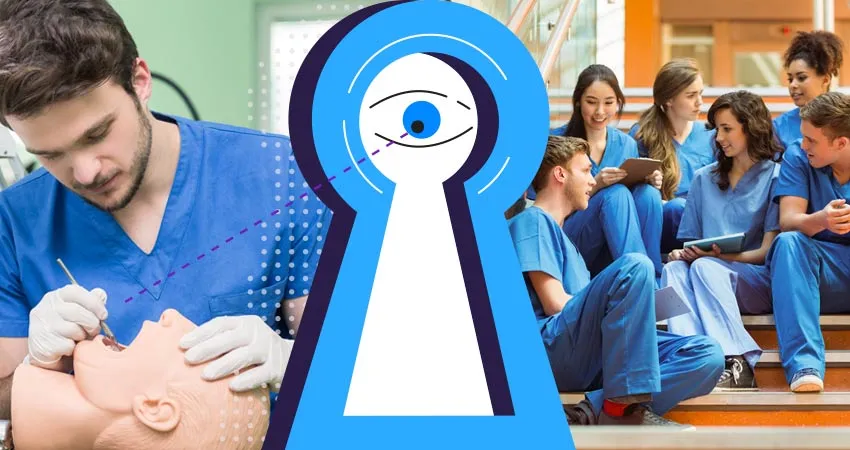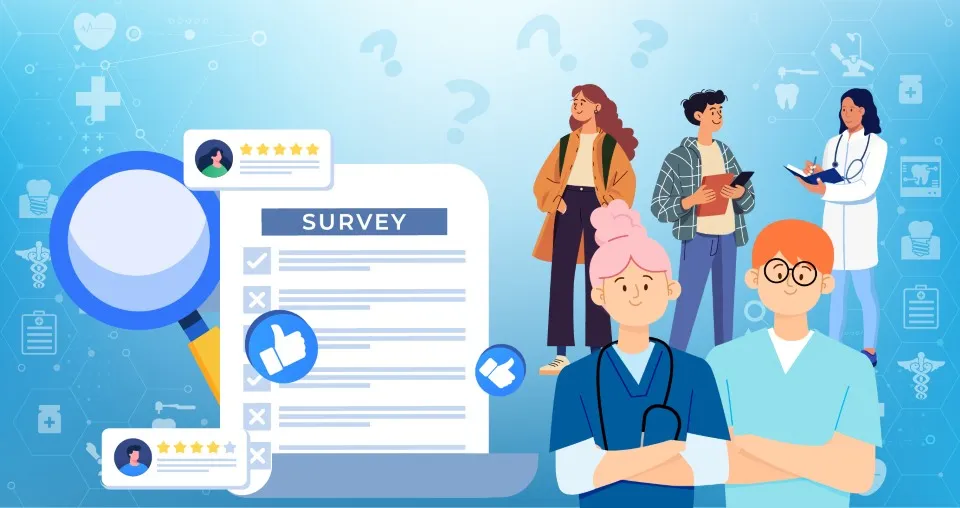Understanding (and Overcoming) the Barriers to Simulation-Based Learning in Nursing and Dental Education

There’s a long-standing gap between theory and practice in healthcare education.
As a 2025 article published in BMC Medical Education puts it, ‘nursing students’ (though this is equally applicable to a range of fields) ‘often struggle to transfer classroom-acquired knowledge into real-world clinical environments’.
This is a completely understandable phenomenon, and it’s one which (as the authors point out) can lead to outcomes that damage institutional reputation, including:
- Decreased confidence
- Impaired decision-making
- Compromised patient care
And this isn’t an observation limited to educators or researchers. Students are well aware of this gap, as reflected in Immersify survey data: in fact, a third of our 348 student respondents cited hands-on clinical skills practice as the one factor that would most improve their educational experience.
With student expectations, clinical readiness, and institutional reputation at stake, university leaders can’t ignore avenues for addressing the theory-practice gap. And, according to the same BMC article, there is a solution in the form of simulation: an approach professionally recognized by bodies like the Nursing and Midwifery Council which has been shown to close or reduce the gap through improvements to clinical decision-making, judgment, or self-confidence across 12 studies.
But while the case for simulation is clear, the fact remains that even proven solutions face barriers. Read on to discover the most common obstacles to simulation-based learning (and how the right approaches and technologies can help institutional leaders overcome them).

3 Barriers to Simulation-Based Learning, From Complex Dental Simulators to Restricted Nursing Simulation Labs
When it comes to understanding simulation-related challenges, there’s no better place to begin than in the views of healthcare faculty. This was the approach taken in a 2025 study published in BMC Nursing, which identified several themes that cover the barriers to leveraging educational simulation.
Keep reading for the full breakdown.
1) Space-Related Limitations
Hardware-based simulation is limited by the number of users that can access it at any given time.
The BMC Nursing article is quick to identify limited nursing simulation lab spaces as a key barrier to simulation use. As one respondent said, ‘Our space is quite small compared with the equipment we have. As such, not many students can enter, and not everyone gets to use it adequately.’
The idea that sim labs and equipment have limited spaces is frustrating, since part of their role is to compensate for limited opportunities to practice clinical skills on patients. As a BMC Medical article from 2024 points out, ‘dental students receive inadequate patient care experience’ and ‘often graduate with inadequate [...] clinical experience to provide care for geriatric, specialized pediatric, and medically compromised patients.’
When this kind of real-life case variety is already limited, it’s counter-intuitive that dental simulators and nursing simulation labs—technologies that should act as good substitutes for those limitations—are subject to similar restrictions.
MORE ON LIMITED ACCESS TO HANDS-ON PRACTICE | ‘Why Nursing Rotations Are Under Pressure (And How to Protect Student Readiness)’
Reframing Nursing and Dental Simulation: A World Beyond Hardware
At heart, this barrier stems from a limited conception of how simulation-based learning needs to look.
Nursing skills labs and benchtop dental simulators have an important part to play in these disciplines, but hardware-heavy setups can be prohibitive for institutions that lack the space to store, maintain, and make the most of them. And even then, these systems are intrinsically limited: as the respondent above pointed out, only so many students can access them at once.
A more flexible alternative or supplement to hardware lies in digital simulation.
Digital simulation supplies scalable resources that immerse the learner in experiences such as:
- Augmented reality
- Gamified activities
- Interactive dentistry and nursing simulation scenarios
And, crucially, these forms of simulation can be accessed anytime, anywhere, and on readily available devices, ensuring learners are better able to access the performance-boosting benefits of simulation without waiting in line. 
2) Faculty Expertise and Cultural Resistance
Some hardware-based systems are complicated to operate.
For the authors of the BMC Nursing article, a lack of staff expertise shone through respondents’ descriptions of simulation barriers. The study underscores:
- Excessive setup time
- Limited operational skills
- Difficulty understanding simulation equipment
The complexities above can also lead to an understandable hesitancy among staff: the need for hard skills here underscores how challenging adoption can be, and simulation can begin to feel like another burden for already stretched faculty.
But given the effectiveness of simulation as a learning tool, institutions can’t afford not to embrace it. As noted by the ADHA’s Dr. JoAnn Gurenlian during an Immersify webinar:
‘The worst words in the English language are: “This is the way we’ve always done it.”’
GET ALL 5 TAKEAWAYS FROM ADA AND ADHA LEADERS | ‘5 Key Takeaways from “Beyond the Buzzword: Rethinking Technology as a Catalyst for Curriculum Transformation”’
How Technology Acceptance Shifts From Skills Labs to Laptops
While these barriers might feel tough to surmount, they’re better understood as reminders that simulation is far from a zero-sum game: there are plenty of points on the spectrum between ‘nothing’ and ‘high-fidelity nursing skills labs’.
As far back as 1989, which saw the publication of Fred Davis’ foundational article on user acceptance of information technology, it’s been well established that system use correlates to two key factors:
- Perceived usefulness
- Ease of use
Nobody’s denying the usefulness of simulation-based learning, especially in hands-on healthcare disciplines like dentistry and nursing. The barrier here pertains to ease of use: simulation technology is often thought of in terms of complex machinery.
While efforts to upskill staff on these devices are absolutely important, and while nursing skills labs and similar larger-scale simulators remain essential for a well-rounded healthcare education, this is also a reminder for institutional leaders that simulation can equally live on familiar ground. The smartphones and desktops that academics (and students) are accustomed to using day-to-day can be powerful simulation tools, especially when backed by platforms offering augmented reality experiences and branching case studies.
These devices qualify as immersive technologies, but they carry far lower operational barriers. In short: they’re the perfect way to foster the wider adoption and acceptance of simulation-based learning.
KEEP READING ABOUT DIGITAL DENTAL AND NURSING SIMULATION | ‘Does Digital Simulation-Based Learning Actually Work? What the Evidence Says For Healthcare Education’
3) Discrepancy with Clinical Practice
In some cases, simulation systems don’t give an up-to-date depiction of clinical environments.
This is a thread the BMC Nursing picks out an interesting thread among its respondents. It charts concerns that simulation systems are out of date, failing to reflect the scenarios, equipment, advances, and technologies that reflect real-life clinical practice. As one respondent puts it in the article, ‘they are a bit behind the time.’
As Immersify’s own Nursing Educaton Lead, Hilary Gupte (RN) points out, some simulators can lack versatility and flexibility, too: part task trainers are often single-purpose and manikins have pre-set limitations: they can either dilate their pupils or they can’t, for example. As a result, there will likely be some non-real elements that detract from simulation’s key purpose of feeling lifelike.
As barriers go, these are fundamental: David Gaba’s often-cited definition of simulation hinges on replicating substantial aspects of the real world. If simulation lags behind reality (or causes users to step out of the scenario), it stops being simulation at all, and becomes more of a hindrance than a help.
The Importance of Curriculum Alignment for Nurse Simulation and Dental Simulation Games
Unlike previous barriers, this one is less a reflection of the technologies educators use, and is perhaps better positioned as a limitation of service.
The degree to which simulations reflect (and keep pace with) current clinical environments and contexts will depend on the vendor that institutions use to supply their simulation systems.
The goal, here, should be to prioritise services that stay clinically and pedagogically relevant. That means services that come pre-mapped to curricula and, crucially, which have the infrastructure to allow for rapid updates in line with changes to:
- Program content
- Learning standards like CODA or the AACN Essentials
- Developments in your program’s discipline more broadly
As Gaba points out, simulation itself isn’t about any specific kind of technology, and the same is true of how up to date a given system is. The key question leaders need to consider here is, instead, how well a given system can align with, and keep pace with, existing curricula.
DISCOVER THE BENEFITS OF CURRICULUM-ALIGNED PLATFORMS, FROM FLIPPED CLASSROOMS TO PREMATRICULATION | ‘Fitting the Pieces Together: 3 Easy Ways to Embed Curriculum Aligned Learning Technology into Core Modules’
Future Directions: Looking Beyond Nursing Skills Labs and Dental Simulators
Ultimately, simulation-based learning succeeds not through isolated hardware purchases, but through ongoing alignment with:
- Space restrictions
- Familiar, day-to-day technologies
- Curriculum frameworks and the clinical realities behind them
Institutions that treat dentistry and nurse simulation as an evolving service rather than a static tool are best placed to overcome the barriers outlined above. The next step is not simply choosing whether to use simulation, but choosing how to implement it sustainably, accessibly, and at scale.
Frequently Asked Questions on Nursing and Dental Simulation Barriers
Nursing simulation labs can be highly effective, but they often come with logistical and operational challenges. Even when institutions possess a simulation lab nursing faculty can use, teams can still run up against:
- High equipment costs
- Limited lab space
- Restricted student access
- Time-intensive setup requirements
Faculty may also lack training or confidence in operating simulation equipment, or even worry about students breaking it, all of which can lead to underutilization. Because these labs depend on specialised hardware, scalability is limited unless institutions adopt more flexible, smartphone- or computer-based simulation formats.
Dental simulators are valuable tools for developing psychomotor skills and procedural confidence, particularly in pre-clinical stages.
However, dental simulations depend on access and realism. If dental simulators are restricted to lab environments, their impact is reduced.
Digital dental simulators can help extend practice beyond the bench, allowing students to bridge the theory-practice gap regardless of location and with the devices already sitting in their pockets.
Simulated scenarios play a key role in preparing nursing students for hands-on training: they’re the connective tissue between theory and practice.
They provide safe environments to rehearse decision-making, practical procedures, and both technical and non-technical skills without risk to patients.
And when they’re aligned with current standards and delivered consistently across cohorts, simulation scenarios act as a reliable substitute for reduced clinical placement opportunities.
The Key Takeaway on the Obstacles Blocking Simulation-Based Learning
Hardware-based simulators absolutely have a part to play in nursing, dentistry, and broader healthcare disciplines. But the fact remains that these devices can:
- Impose space- and time-related limitations that mirror the constraints of real patient access
- Demand faculty upskilling, which (combined with the cost of possible repairs) can leave this valuable form of education underused
- Lose touch with current clinical realities, undermining the key basis of effective simulation
These obstacles aren’t insurmountable. And, in fact, the most immediate and impactful way to overcome them is by widening the scope of simulation-based learning to encompass not just hardware, but curriculum aligned digital platforms that offer opportunities to practice hands-on skills and clinical judgment from devices that faculty are immediately familiar with.
Looking to Embrace Simulation Without the Restrictions?
Immersify’s digital-first, screen-agnostic platform comes pre-aligned to your curriculum, offering instant access to a range of nursing and dental simulation games, quizzes, lessons, and more. Authored by experts and housed in the devices and formats faculties use every day, Immersify helps institutions unlock the pedagogical power of simulation without the cost, space limitations, or stagnancy of hardware alternatives.
Book a demo today to experience Immersify for yourself.
This article was reviewed for clinical accuracy and educational relevance by Hilary Gupte (BSc, PGCE), a registered nurse and experienced clinical educator.
Join our mailing list
Get the latest updates on immersive learning, industry trends, and resources delivered straight to your inbox.



